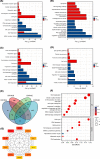INK4 cyclin-dependent kinase inhibitors as potential prognostic biomarkers and therapeutic targets in hepatocellular carcinoma
- PMID: 35771229
- PMCID: PMC9284345
- DOI: 10.1042/BSR20221082
INK4 cyclin-dependent kinase inhibitors as potential prognostic biomarkers and therapeutic targets in hepatocellular carcinoma
Abstract
The INK4 family is an important family of cyclin-dependent kinase inhibitors (CDKIs) and consists of CDKN2A, CDKN2B, CDKN2, and CDKN2D. Abnormal expression of CDKN2A has been reported in hepatocellular carcinoma (HCC) and is associated with the prognosis of patients and infiltration of immune cells. However, there is a lack of systematic research on the roles of the other INK4 family members in the diagnosis, prognosis, and immune regulation of HCC. Using online public databases and clinical samples, we comprehensively analyzed the INK4 family in HCC. All four INK4 proteins were overexpressed in HCC and correlated with advanced cancer stage and poor prognosis. INK4 expression accurately distinguished tumor from normal tissue, particularly CDKN2A and CDKN2C. The INK4 family participated in cell-cycle regulation and the DNA damage repair pathway, which inhibited genotoxic-induced apoptosis in tumorigenesis. INK4 proteins were positively correlated with the infiltration of immune cells (B cells, CD8+ T cells, CD4+ T cells, macrophages, neutrophils, and dendritic cells) and immune checkpoints (CTLA-4, PD1, and PD-L1). CDKN2D had the highest correlation (correlation coefficient >0.3) with all the above-mentioned infiltrating immune cells and immune checkpoints, indicating that it may be useful as an immunotherapy target. The INK4 family was valuable for diagnosis and predicting the prognosis of HCC and participated in the occurrence, progression, and immune regulation of HCC, demonstrating its potential as a diagnostic and prognostic biomarker and therapeutic target in HCC.
Keywords: Hepatocellular carcinoma; INK4; biomarkers; immune; prognosis.
© 2022 The Author(s).
Conflict of interest statement
The authors declare that there are no competing interests associated with the manuscript.
Figures






Similar articles
-
CDKN2A is a prognostic biomarker and correlated with immune infiltrates in hepatocellular carcinoma.Biosci Rep. 2021 Oct 29;41(10):BSR20211103. doi: 10.1042/BSR20211103. Biosci Rep. 2021. PMID: 34405225 Free PMC article.
-
CDK1, CCNB1, and CCNB2 are Prognostic Biomarkers and Correlated with Immune Infiltration in Hepatocellular Carcinoma.Med Sci Monit. 2020 Aug 31;26:e925289. doi: 10.12659/MSM.925289. Med Sci Monit. 2020. PMID: 32863381 Free PMC article.
-
High expression of PDZ-binding kinase is correlated with poor prognosis and immune infiltrates in hepatocellular carcinoma.World J Surg Oncol. 2022 Jan 22;20(1):22. doi: 10.1186/s12957-021-02479-w. World J Surg Oncol. 2022. PMID: 35065633 Free PMC article.
-
Molecular mechanism underlying the functional loss of cyclindependent kinase inhibitors p16 and p27 in hepatocellular carcinoma.World J Gastroenterol. 2008 Mar 21;14(11):1734-40. doi: 10.3748/wjg.14.1734. World J Gastroenterol. 2008. PMID: 18350604 Free PMC article. Review.
-
Systematic summarization of the expression profiles and prognostic roles of the dishevelled gene family in hepatocellular carcinoma.Mol Genet Genomic Med. 2020 Sep;8(9):e1384. doi: 10.1002/mgg3.1384. Epub 2020 Jun 26. Mol Genet Genomic Med. 2020. PMID: 32588988 Free PMC article.
Cited by
-
Construction of CDKN2A-related competitive endogenous RNA network and identification of GAS5 as a prognostic indicator for hepatocellular carcinoma.World J Gastrointest Oncol. 2024 Apr 15;16(4):1514-1531. doi: 10.4251/wjgo.v16.i4.1514. World J Gastrointest Oncol. 2024. PMID: 38660664 Free PMC article.
-
Emerging approaches to CDK inhibitor development, a structural perspective.RSC Chem Biol. 2022 Dec 14;4(2):146-164. doi: 10.1039/d2cb00201a. eCollection 2023 Feb 8. RSC Chem Biol. 2022. PMID: 36794018 Free PMC article.
-
CDK4/6 inhibitors in breast cancer therapy: mechanisms of drug resistance and strategies for treatment.Front Pharmacol. 2025 May 12;16:1549520. doi: 10.3389/fphar.2025.1549520. eCollection 2025. Front Pharmacol. 2025. PMID: 40421216 Free PMC article. Review.
References
-
- , Global Burden of Disease Liver Cancer Collaboration Akinyemiju T., Abera S., Ahmed M., Alam N., Alemayohu M.A.et al. . (2017) The burden of primary liver cancer and underlying etiologies from 1990 to 2015 at the global, regional, and national level: results from the Global Burden of Disease Study 2015. JAMA Oncol. 3, 1683–1691 10.1001/jamaoncol.2017.3055 - DOI - PMC - PubMed
MeSH terms
Substances
LinkOut - more resources
Full Text Sources
Medical
Research Materials
Miscellaneous

